Index
For years, SilverStone has strived to deliver uncompromised airflow performance value for its enthusiast customers. With a history in building full-size, all-aluminum tower cases dating back to 1999, we fully expect the company’s R&D team to have refined its manufacturing process and thermal design concept to improve cooling while keeping fan noise to a minimum.
Many performance-oriented chassis manufacturers usually equip their designs with several different types of case fans, each of which holds its own respective purpose for either exhaust or intake. As SilverStone explains, when the combined airflow of intake fans is greater than the combined airflow of exhaust fans, a positive pressure is created inside the chassis. Conversely, when the combined airflow of exhaust fans is greater than the combined airflow of intake fans, a negative pressure is created. The first two SilverStone chasses to incorporate this airflow methodology were the Sugo SG03 in 2007 and the Fortress FT01 in 2008. They have optimized support for high-end GPUs and filters to prevent dust build-up for longer service life.
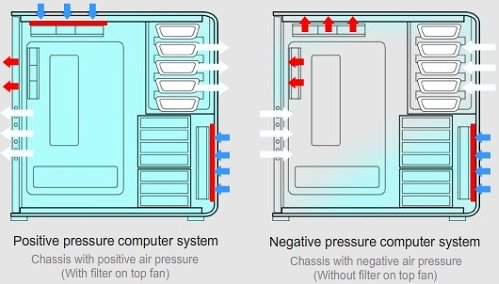
SilverStone's positive airflow diagram
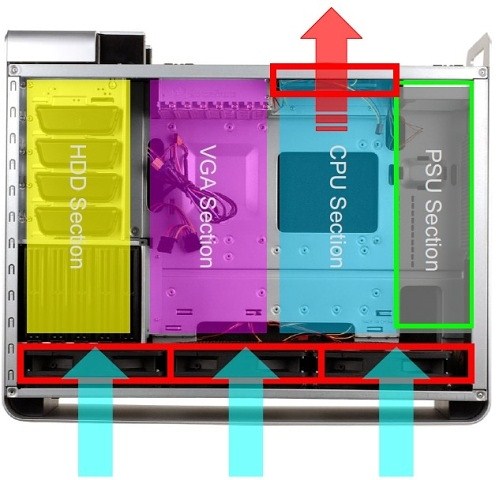
Fortress FT02 airflow pathways and ventilation shaft
The interior contours of the Fortress FT02, in combination with its dedicated vents, fans and pathways are exclusively designed to maximize positive airflow inside the chassis. Like the Raven RV02, it features three SilverStone FN181 180mm sleeve bearing fans that operate at 12V and are advertised with up to 100CFM airflow at just 18dBa. In terms of actual air pressure and noise levels, however, the FT02 includes three fan switches right under its top mesh to toggle between “High” and “Low” settings. In particular, the fan speeds can be toggled between 700RPM and 1000RPM and are generally useful for those wishing to maximize airflow where ambient heat dissipation is needed most, while minimizing fan noise from unneeded performance zones like a hard drive bay with only a single drive. In our test usage scenario, we set the center and right fans at 1000RPM to maximize airflow to our dual-GPUs and CPU socket area, and we set the left fan at 700RPM over the hard drive bays to cool a single 3.5-inch Seagate Barracuda 7200.11 SATA II drive.

The Fortress FT02 houses three SilverStone FN181 180mm sleeve bearing fans
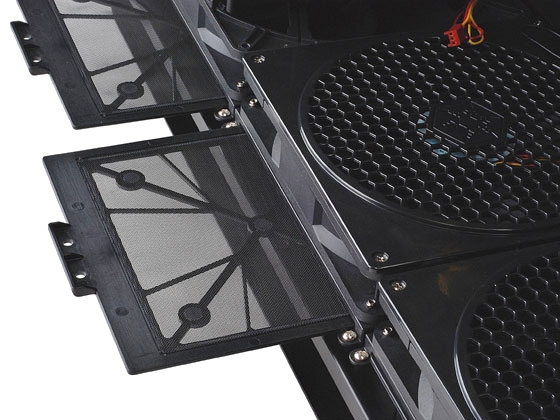
Intake airflow dust filters are essential to SilverStone's positive airflow methodology
While the Fortress FT02’s speed-adjustable fans are ideal for maximizing air intake with positive pressure and stack effect cooling, the large space they occupy at the bottom of the chassis can also be suitable for installing a large 360mm or 420mm radiator provided enough room for GPU placement.
This brings us to our next subject – GPU placement and size restrictions. When SilverStone introduced the Raven RV02 in July 2009, it emphasized that the chassis supported one extra PCI-Express expansion slot over the common seven supported for a normal ATX chassis, which allows the chassis to accommodate up to four 10.5-inch dual-slot GPUs. Shortly afterward, it released a Raven RV02 product info page with an image depicting the chassis as perfectly capable of supporting ATI’s infamously long 12.2-inch Radeon HD 5970. Little did we know, however, that the company was hiding an essential secret about fitting the card into the Raveon RV02. Upon closer inspection of the tiny image on the info sheet page, it appears that the filter on the middle fan was removed in order to accommodate an extra 0.2 inches of vertical space for ATI’s massive dual-GPU Hemlock solution.
With our heads buried in disappointment after the Raven RV02 fan situation, we decided to test whether or not our Radeon HD 5970s would fit in the Fortress FT02 (SST-FT02-B) review unit. Sure enough, SilverStone left the vertical dimensions of the PCI/PCI-Express mounting slots exactly the same length (12 inches), which did absolutely nothing to change our dilemma.
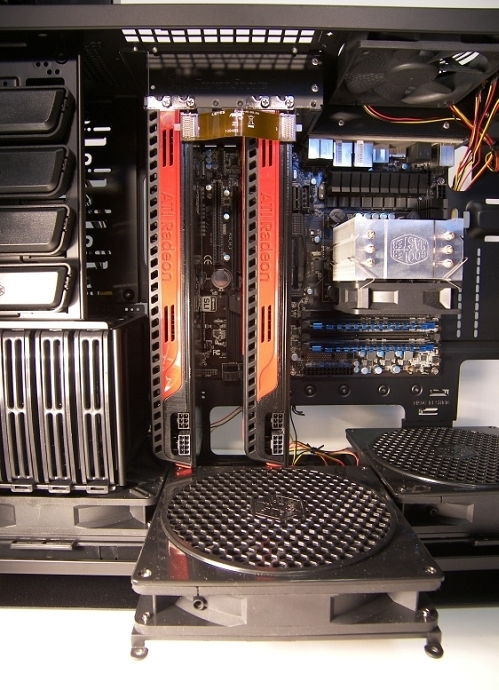
Two ATI Radeon HD 5970 graphics cards in the SilverStone Fortress FT02 chassis
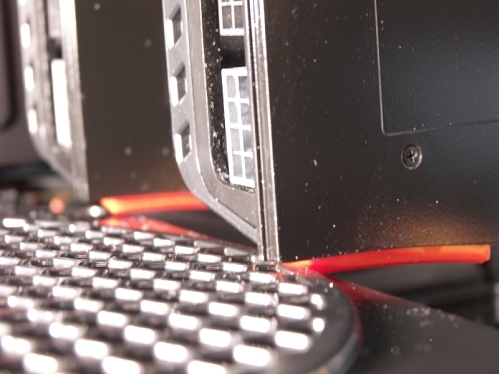
ATI’s 0.2-inch red fins prevent Radeon HD 5970 clearance
After quickly skimming over the Fortress FT02 product info page, we noticed that the company also posted an image of the Radeon HD 5970 fitting perfectly inside the FT02 chassis. In perspective, it is important to keep in mind that ATI released its flagship dual-GPU card in November 2009, whereas SilverStone finalized production of the Fortress FT02 in December 2009. At this point, we are not sure whether to blame ATI for including such useless 0.2-inch red fins on the bottom of the Radeon HD 5970, or SilverStone for claiming that its second-generation Fortress would fully support the longest consumer GPU in history without any need for modifications. After speaking with SilverStone about Radeon HD 5970 installation, we were able to get our two monstrous cards installed by removing the middle 180mm fan filter. The resulting outcome is that the center fan is 0.2 inches shorter than the left and right fans, providing sufficient installation space for two Radeon HD 5970 graphics cards.



